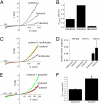General anesthetics activate a nociceptive ion channel to enhance pain and inflammation
- PMID: 18574153
- PMCID: PMC2438393
- DOI: 10.1073/pnas.0711038105
General anesthetics activate a nociceptive ion channel to enhance pain and inflammation
Abstract
General anesthetics (GAs) have transformed surgery through their actions to depress the central nervous system and blunt the perception of surgical insults. Counterintuitively, many of these agents activate peripheral nociceptive neurons. However, the underlying mechanisms and significance of these effects have not been explored. Here, we show that clinical concentrations of noxious i.v. and inhalation GAs excite sensory neurons by selectively activating TRPA1, a key ion channel in the pain pathway. Further, these GAs induce pain-related responses in mice that are abolished in TRPA1-null animals. Significantly, TRPA1-dependent neurogenic inflammation is greater in mice anesthetized with pungent compared with nonpungent anesthetics. Thus, our results show that TRPA1 is essential for sensing noxious GAs. The pronociceptive effects of GAs combined with surgical tissue damage could lead to a paradoxical increase in postoperative pain and inflammation.
Conflict of interest statement
Conflict of interest: Georgetown University has filed a provisional patent relating to this study.
Figures






Similar articles
-
Identification of a putative binding site critical for general anesthetic activation of TRPA1.Proc Natl Acad Sci U S A. 2017 Apr 4;114(14):3762-3767. doi: 10.1073/pnas.1618144114. Epub 2017 Mar 20. Proc Natl Acad Sci U S A. 2017. PMID: 28320952 Free PMC article.
-
Pungent general anesthetics activate transient receptor potential-A1 to produce hyperalgesia and neurogenic bronchoconstriction.Anesthesiology. 2010 Jun;112(6):1452-63. doi: 10.1097/ALN.0b013e3181d94e00. Anesthesiology. 2010. PMID: 20463581
-
The contribution of TRPM8 and TRPA1 channels to cold allodynia and neuropathic pain.PLoS One. 2009 Oct 8;4(10):e7383. doi: 10.1371/journal.pone.0007383. PLoS One. 2009. PMID: 19812688 Free PMC article.
-
The role of TRPA1 in visceral inflammation and pain.Channels (Austin). 2011 Nov-Dec;5(6):525-9. doi: 10.4161/chan.5.6.18016. Epub 2011 Nov 1. Channels (Austin). 2011. PMID: 21993194 Free PMC article. Review.
-
Transient Receptor Potential Channels in neuropathic pain.Curr Opin Pharmacol. 2017 Feb;32:9-15. doi: 10.1016/j.coph.2016.10.002. Epub 2016 Oct 27. Curr Opin Pharmacol. 2017. PMID: 27835802 Review.
Cited by
-
Propofol causes vasodilation in vivo via TRPA1 ion channels: role of nitric oxide and BKCa channels.PLoS One. 2015 Apr 1;10(4):e0122189. doi: 10.1371/journal.pone.0122189. eCollection 2015. PLoS One. 2015. PMID: 25830814 Free PMC article.
-
The antinociceptive and antihyperalgesic effects of topical propofol on dorsal horn neurons in the rat.Anesth Analg. 2013 Apr;116(4):932-8. doi: 10.1213/ANE.0b013e31827f560d. Epub 2013 Jan 21. Anesth Analg. 2013. PMID: 23337417 Free PMC article.
-
Propofol restores TRPV1 sensitivity via a TRPA1-, nitric oxide synthase-dependent activation of PKCε.Pharmacol Res Perspect. 2015 Aug;3(4):e00153. doi: 10.1002/prp2.153. Epub 2015 Jun 11. Pharmacol Res Perspect. 2015. PMID: 26171233 Free PMC article.
-
Sensory TRP channels: the key transducers of nociception and pain.Prog Mol Biol Transl Sci. 2015;131:73-118. doi: 10.1016/bs.pmbts.2015.01.002. Epub 2015 Feb 12. Prog Mol Biol Transl Sci. 2015. PMID: 25744671 Free PMC article. Review.
-
Inhibition of inflammatory pain and cough by a novel charged sodium channel blocker.Br J Pharmacol. 2021 Oct;178(19):3905-3923. doi: 10.1111/bph.15531. Epub 2021 Jun 21. Br J Pharmacol. 2021. PMID: 33988876 Free PMC article.
References
-
- Hemmings HC, Jr, et al. Emerging molecular mechanisms of general anesthetic action. Trends Pharmacol Sci. 2005;26:503–510. - PubMed
-
- Tan CH, Onsiong MK. Pain on injection of propofol. Anaesthesia. 1998;53:468–476. - PubMed
-
- Picard P, Tramer MR. Prevention of pain on injection with propofol: A quantitative systematic review. Anesth Analg. 2000;90:963–969. - PubMed
-
- Doenicke AW, Roizen MF, Rau J, Kellermann W., Babl J. Reducing pain during propofol injection: The role of the solvent. Anesth Analg. 1996;82:472–474. - PubMed
-
- MacIver MB, Tanelian DL. Volatile anesthetics excite mammalian nociceptor afferents recorded in vitro. Anesthesiology. 1990;72:1022–1030. - PubMed
Publication types
MeSH terms
Substances
LinkOut - more resources
Full Text Sources
Other Literature Sources
Medical
Molecular Biology Databases

